The evolution of Chinese destroyers
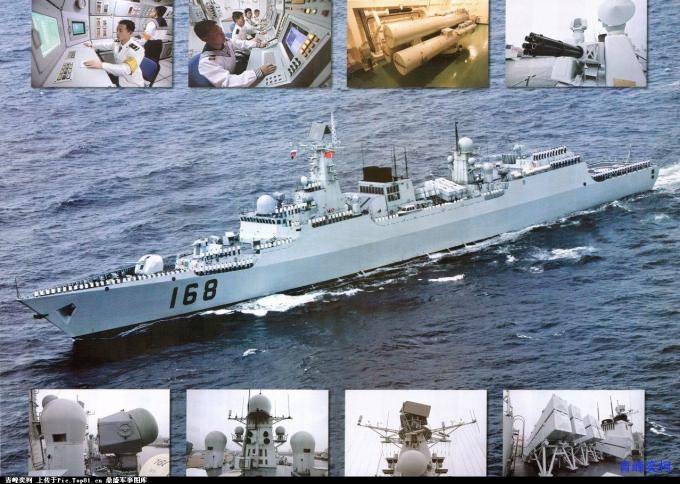
The development of this class of ships clearly shows the progress of Chinese military shipbuilding. Yes, Chinese shipbuilders borrow and buy weapons and electronics; adopt modern design technologies; invite experts from abroad. But in the end, they formed a fairly distinctive look of warships.
Before starting a conversation about the most modern Chinese EM fleet, you should talk about the project, which served as a kind of forerunner to later developments.
In the late 90s, the line of destroyers of the Chinese fleet was to be continued by the Luhai-class destroyer of project 051B (NATO code DDG "Luhai-class"), built with the preservation of the fundamental decisions and functional purpose of the prototype. The initial volume of the conceived series of these ships is not known for certain, but by 1999 only one “hull” was put into operation - the Shenzhen EM (board No. 167).
According to some reports, it was planned to install unified vertical launchers and multifunctional control systems on the ship, but, apparently, things did not work out: a set weapons and armament remained identical to the destroyers of the project 052 (see below the diagrams and photos in sequence of EM pr. 052 and pr. 051).
EM Project 052 (the lead ship "Harbin". Built at a shipyard in Shanghai. Standard displacement 4800 tons, total 5700 tons. Length is 148 m, width is 16 m, draft is 4,3 m. Power of the combined diesel-gas turbine plant is 72200 hp, speed 31,5 knots Armament: one eight-barrel launcher for the HQ-7 air defense system (Chinese copy of the Naval Krotal air defense system), eight S-802 anti-ship missiles, one twin 100-mm gun mount and four twin 37-mm machine guns, two triple-tube 324-mm torpedo PLO unit, two Z-9 helicopters.In total, two units were built in 1993-1996: "Harbin" and "Qingdao").

1 - 1x2 100-mm AU "type 79"; 2 - 1x8 PU SAM "HQ-7"; 3 - AP radar detection of VTs and NTs "type 360"; 4 - AP SLA "type 347G"; 5 - 1x3 324 mm TA; 6 - PU PLC; 7 - 4x4 PU anti-ship missiles "YJ-82"; 8 - radar VTs and NTs; 9 - early warning radar "type 517"; 10 - 2x37-mm AU "type 76A"
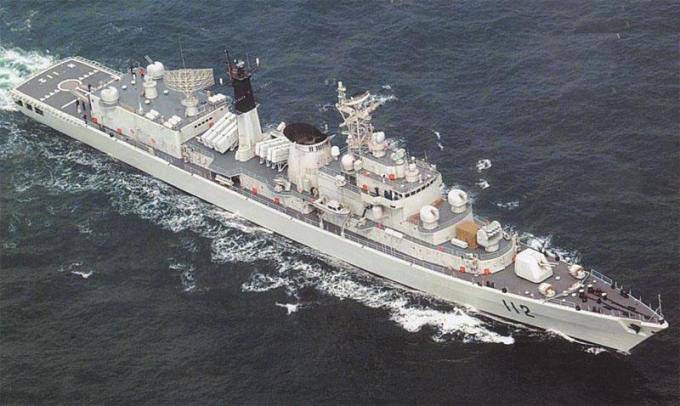
Destroyer URO pr. 051.

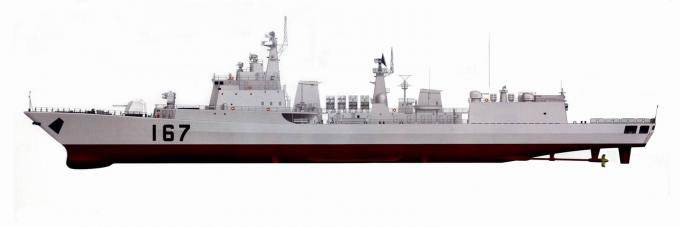
Displacement:
- standard: 6100 tons;
- full: 6600 tons.
Length: 153 meters.
Width: 16,5 meters.
Draft: 6 meters.
Power plant (type x power): 2 gas turbine engines x 24300 hp + 2 Diz. MTU 12V1163TB83 x 4420 HP
Maximum travel speed: 29 nodes.
Cruising range at 15 knots: 14000 miles.
Crew (officers): 250 (42) people.
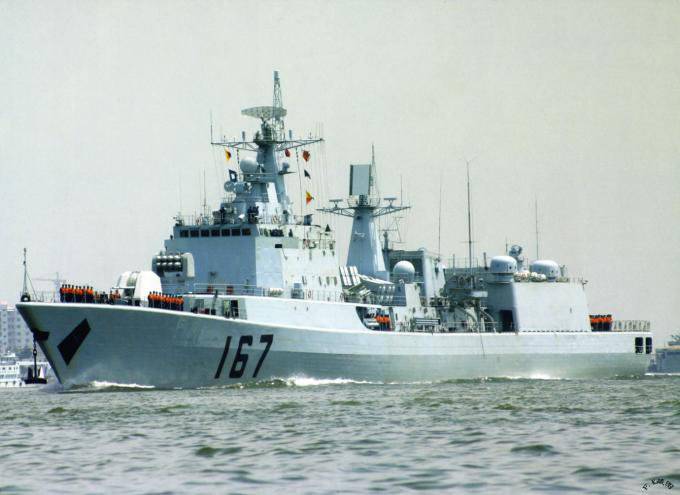
Armament:
- shock: 4x4 anti-ship missiles C-803 / J-8-3;
- anti-aircraft: 1x8 SAM HQ-7 (32);
- artillery: 1x2 100 mm AU TYPE 79A; 4x2 37mm AU TYPE 76A;
- anti-submarine: 2x3 324 mm TA (Mk46 Mod.1 / YU-7);
— aviation: 2 KA-28.
Electronic weapons:
- radar: radar TYPE 517H-1 (OVC); Radar TYPE 360S / DRBV-15 SEA TIGER (OVC / ONC); Radar TYPE 381A (OVTs / ONTS);
- weapon control: 2 TYPE 347G radars (37 mm AU); Radar TYPE 343G (AU, anti-ship missiles); Radar TYPE 345 / CASTOR II (SAM); 2 OES OFD-630
RTR and EW: 2x15 launchers LC TYPE 946; SIGNAAL RAPIDS SRW210A; RAMSES;
- hydroacoustic stations: GAS DUBV-23; GAS DUBV-43 (PBA);
— communication and control system: CIUS TAVITAC; SATCOM.
The backlog of the hulls was used in the future. As a result, the ships of Project 052C appeared in the Chinese Navy, which to some extent became a modern version of the URO frigates of the early - mid-60s (actually enlarged destroyers armed with medium-range air defense systems; typical representatives of the French "Suffren" and American " Farragat").
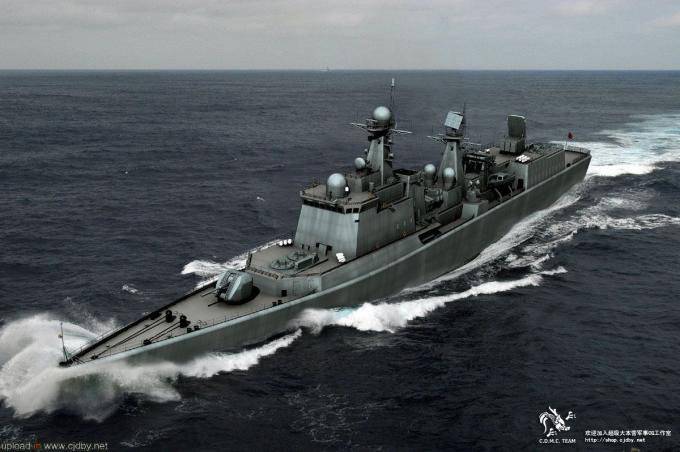

Two destroyers ("Shenyang", tactical number 115; and "Shiyiazhuang", 116) were commissioned in 2006-2007, total displacement 7000/8630 tons; in terms of dimensions, architecture and power engineering, they are identical to the Shenzhen, but a significant improvement is the use on these ships of six eight-shot launchers of the Russian S-300F air defense system, in the export designation - Rif-M, and two MZAK "type 730", in total providing a significant increase in air defense potential.
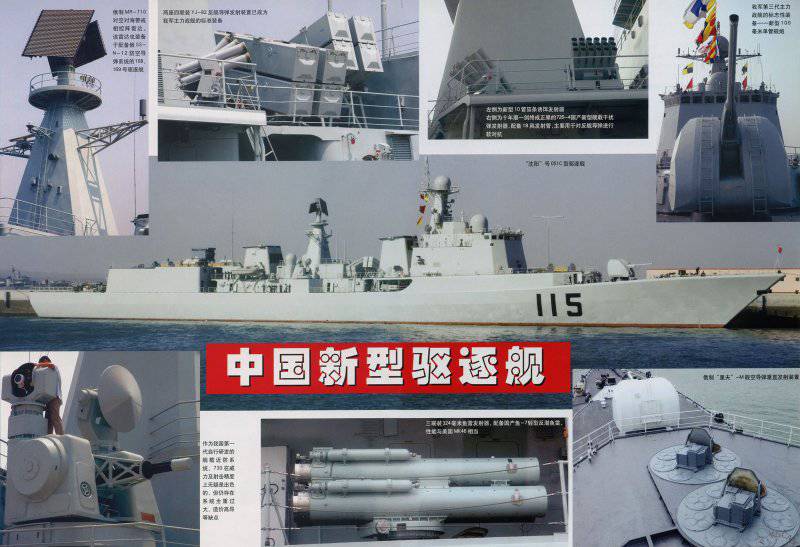
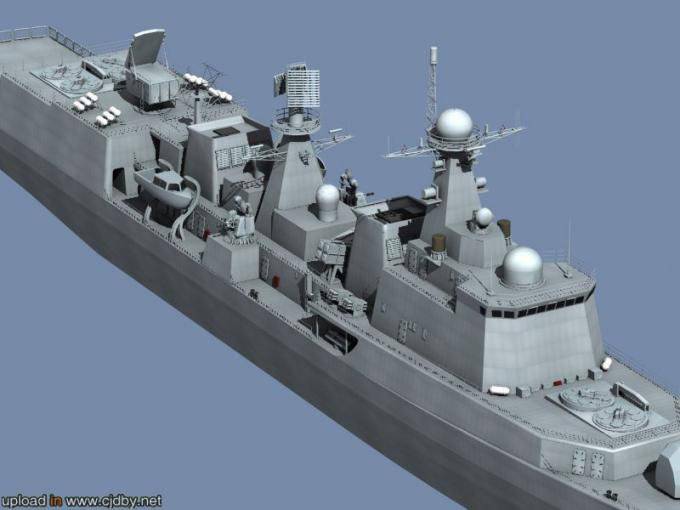
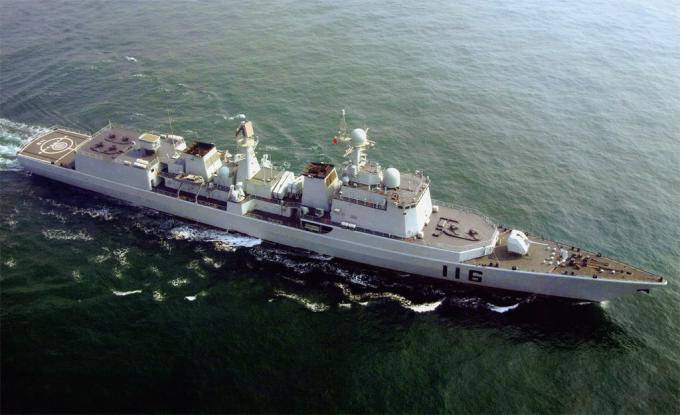
The destroyer "Shijiazhuang" ("second building" pr. 051C), which entered service in 2007. Clearly visible: AP air defense system "Rif-M" (antenna in the "littered" state) on the roof of the aft superstructure, launchers of the air defense system "Rif- M "(in the bow - two launchers, and in the stern - four launchers)
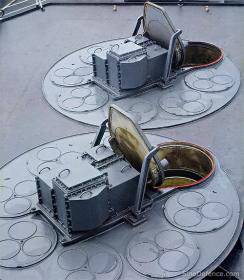
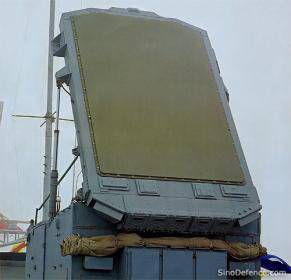
Unfortunately, the radical strengthening of the air defense capabilities had to be paid for by a sharp decrease in the capabilities of the anti-aircraft defense system: due to the placement of the air defense launcher in the aft setting, there was no longer enough space for a helicopter hangar. Although there is a heliport
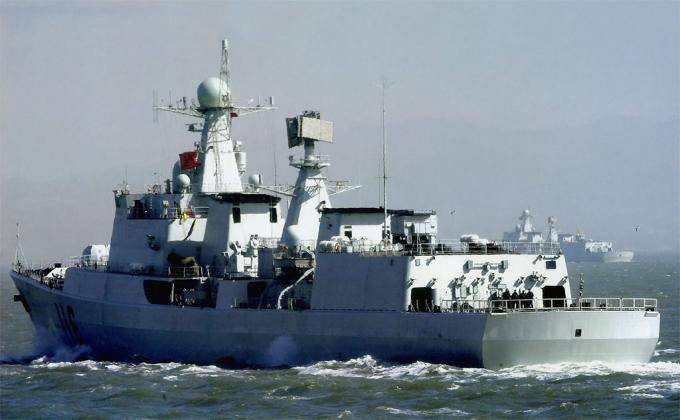
Destroyers of projects 052B and 052C became a separate branch of the development of Chinese shipbuilding - NATO code DDG "Luyang class" and "Luyang-II class", respectively. The ships built “in the same hull and power engineering” were armed with various types of weapons and weapons (despite the fact that the project is designated as 052, with the Luhu-type EM, the NATO code DDG “Luhu-class” they have little in common; in a banal way they larger).
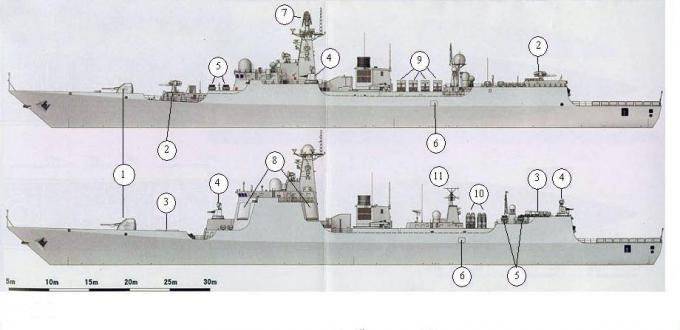
Project 052B destroyers (fig. above) and 052C - general and particular:
1 - 1x1 100-mm AU "Creusot-Loire T100C"; 2 - 1x1 launchers of the Shtil-M air defense system: 3 - 6x6 launchers of the HQ-9 air defense system; 4 - MZAK "type 730"; 5 - 2x18 launchers for setting decoys; 6 - 1x3 324 mm TA; 7 - AP radar "Fregat-ME"; 8 - radar with headlights; 9 - 4x4 anti-ship missile launchers "YJ-83": 10 - 2x4 anti-ship missile launchers "YJ-62": 11 - early warning radar "type 517"
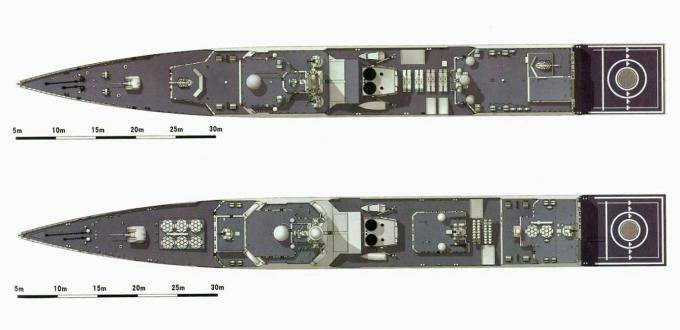
EM "Guangzhou", type 052B
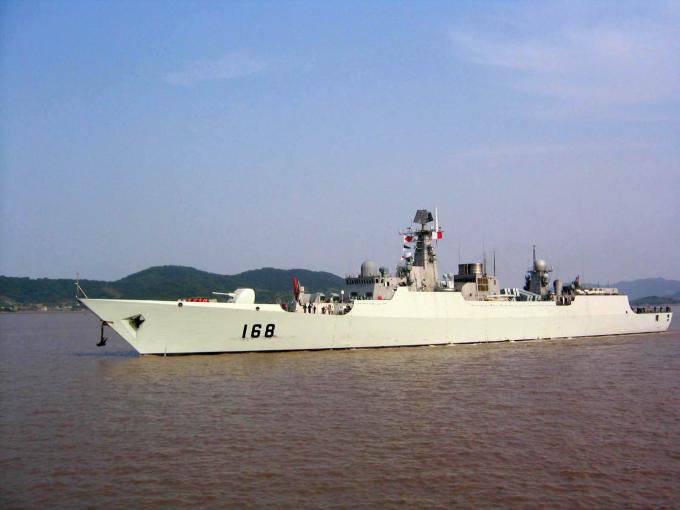

6500/7500 tons; 164/17,2/9,5 m; 2 GTDx36300 + 2 dieselx4900 hp; 32 knots; 4x4 PU anti-ship missiles J-8-3; 2x1 SAM STIHL 1 (48); 100 mm AU; 2x7 30mm ZAK; 2x3 TA; 2x12 RBU; KA-286500/7500 t.; 164/17,2/9,5 m; 2 GTDx36300 + 2 dieselx4900 hp; 32 knots; 4x4 PU anti-ship missiles J-8-3; 2x1 SAM STIHL 1 (48); 100 mm AU; 2x7 30mm ZAK; 2x3 TA; 2x12 RBU; helicopter KA-28
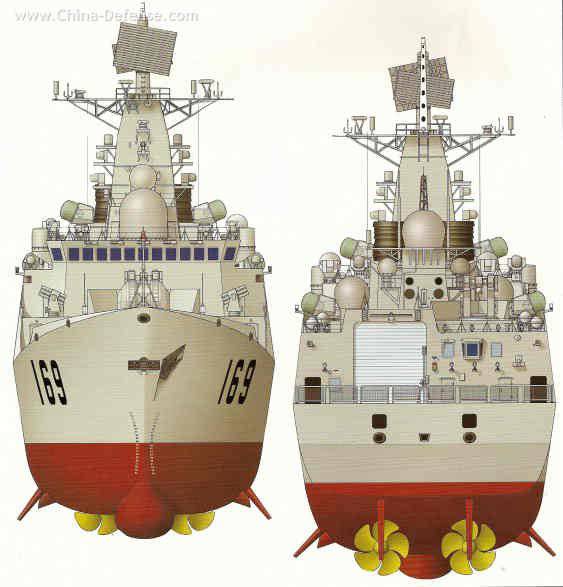
The destroyers are equipped with the ZKJ-7 combat information and control system, the HN-900 automated data transmission line (Chinese analogue of Link-11), the SNTI-240 satellite communications equipment, the Fregat-M3EM 2-axis radar for detecting air targets (Top Plate, E band: aircraft detection range - 230 km, anti-ship missiles - 50 km), four MR-90 (Front Dome) SAM fire control radars, 2 MZAK Type 347G (EFR-1) artillery fire control radars, Type 344 anti-ship missiles and GK artillery fire control radar (Band Stand, I/J band)
There are two ships in the series: "Guangzhou", tactical number 168, and "Wuhan", respectively 169 (built in 2000-2004).
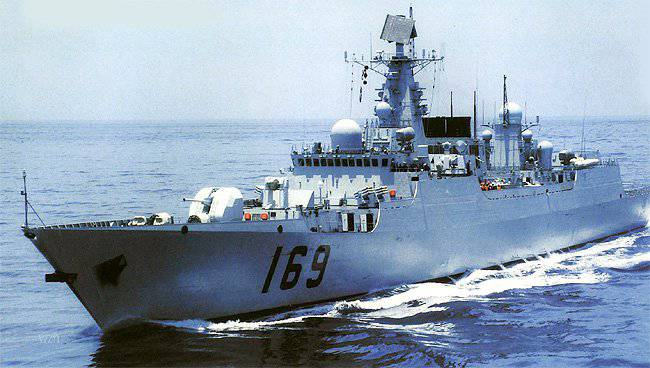
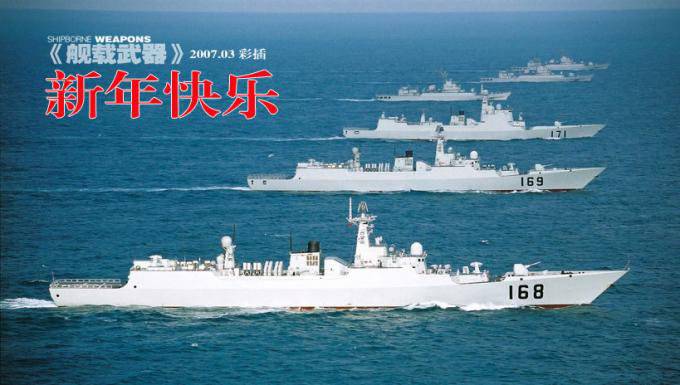
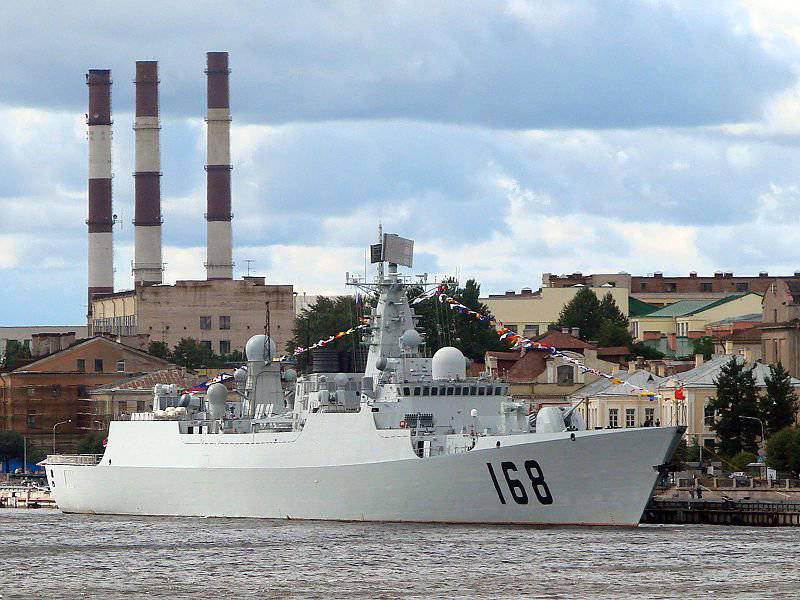
A project that is very balanced in terms of strike capabilities, as well as air defense / anti-aircraft defense. We can say, a very good average. The closest analogue (and even for a number of systems and types of weapons) is the Indian Delhi-class EM
EM "Lanzhou", type 052C.
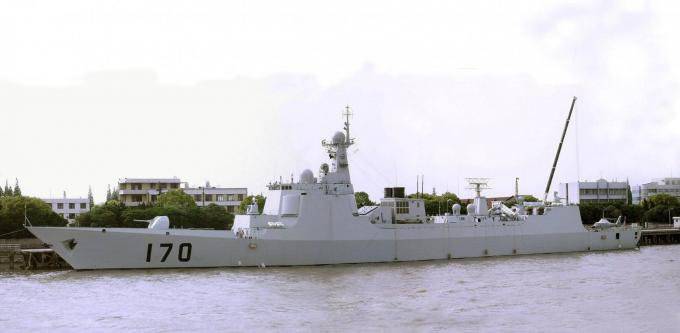
7000 tons; 155/17/6 m.; GTDx48600 hp + diesel x8840 hp; 29 knots; 4500 m.m. (15 knots); 280 (40) people; 2x4 PU anti-ship missiles YJ12; 8x6 UVP SAM HQ-9 or RIF-M; 1x100mm AU; 2x7 30mm ZAK; 2x3 TA; helicopter KA-28
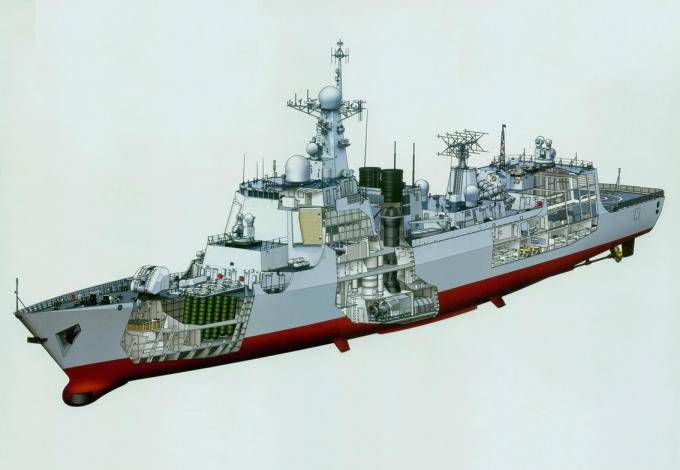
The ships are equipped with the H / ZBJ-1 combat information and control system, the HN-900 automated data transmission line (Chinese analogue of Link-11), SNTI-240 satellite communications equipment, Type 438 radar (S-band, detection range - 450 km) with four headlights developed by the Nanjing Research Institute of Electronic Technology (former 14 Institute), a 2-coordinate radar for detecting air targets Type 571Н-1 Knife Rest, a fire control radar for SCRC and artillery GK MR-331 "Mineral-ME" (Russia), a control radar firing of the MZAK Type 347G Rice Lamp (EFR-1), under-wing sonar SJD8 / 9 (improved DUBV-23) towed sonar ESS-1 (improved DUBV-43). Optoelectronic means: OFC-3 optronic directors. Electronic warfare equipment: 4x18-tube Type 726-4 decoy RL
The EM of this project has pronounced anti-aircraft capabilities, achieved by placing eight (six bow and two stern) six-shot launchers of the Chinese HQ-9 complex, a licensed and modified version of the Russian Rif-M air defense system of zone defense (very, very large sign question. - Approx. doktorkurgan) and two guns "type 730".
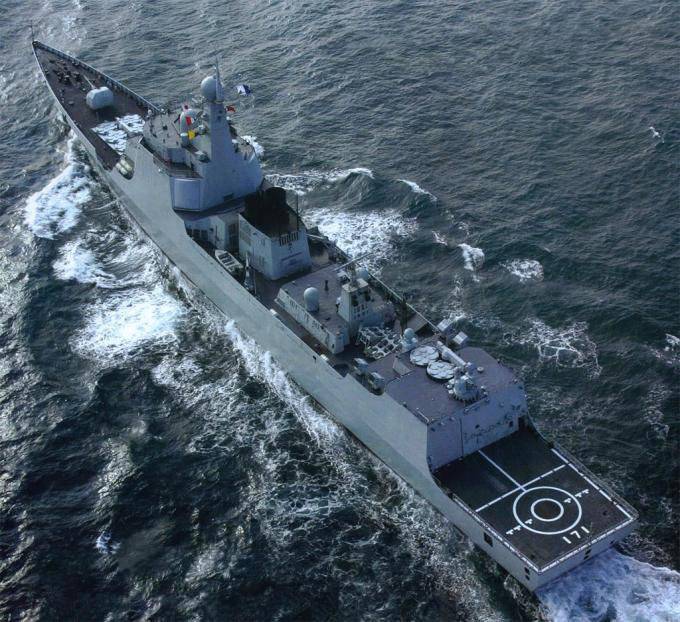
Anti-submarine capabilities have been retained at the level of Project 052B, but the strike capabilities have been quantitatively reduced by half - to eight YJ-62 anti-ship missiles, which, however, have better qualities - a greater flight range and warhead power than the YJ-82.
There are also two ships in the series: "Lanzhou", tactical number 170, entered service in 2004; and "Haikou", 171, 2005
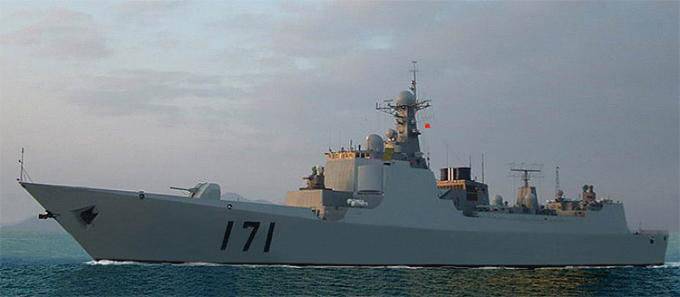
В stories the creation of these ships has a fair amount of borrowed technology. When the Chinese specialists became concerned with the creation of air defense ships, a quite reasonable idea arose to make something like "Aegis, made in China". Accordingly, information about radars with PAR was required. According to available information, those were originally purchased. documentation for the Mars-Passat system, after studying it was recognized that it was hardly possible to adapt it to the project being developed. In parallel, there was a process of copying information on American developments (this was partially revealed at the beginning of the 348s, followed by a trial known in the media as "Chinagate"); apparently, the Chinese experts could not figure it out on their own, they had to involve scientists from the Kvant association. As a result, apparently, the system was brought to mind. The resulting product is called radar type 450, provides detection (probably air targets) at a distance of XNUMX km.
It is interesting to look in comparison with other "Aegis":
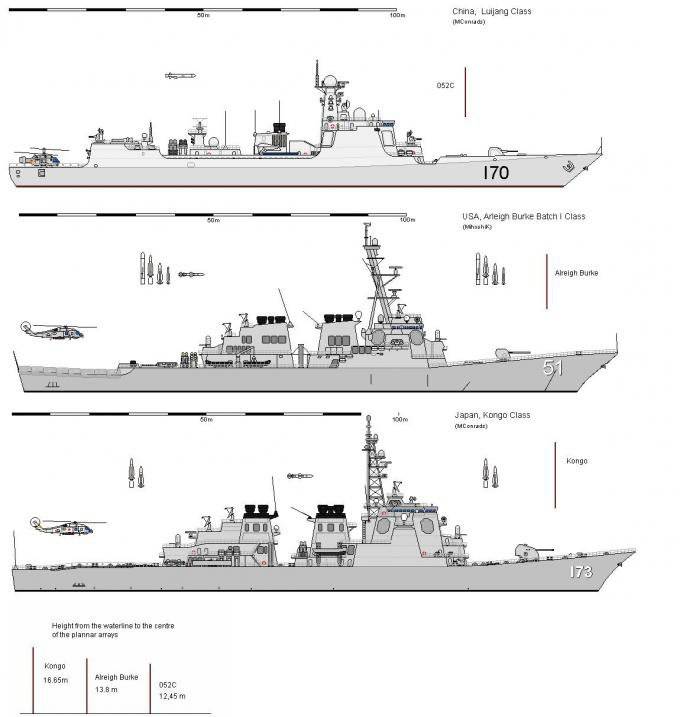
Russian-built destroyers are a separate line in the Chinese fleet Project 956 E ("Yangzhou" 136 and "Fu Zhou" 137; commissioned in 2000 and 2001) and etc. 956 EM ("Taizhou" 138 and "Ningbo" 139; commissioned in 2005 and 2006).
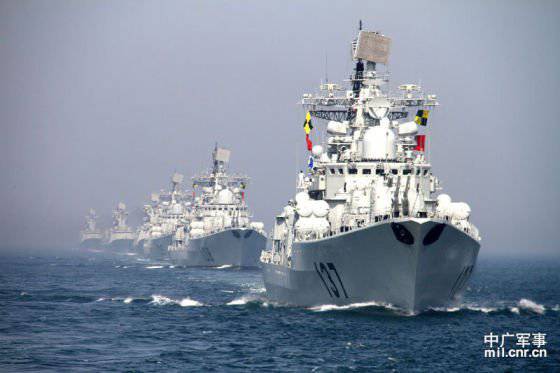
The first two EMs do not differ much from the EMs of the "Modern" type of the Russian fleet, on two ships of Project 956 EM the aft 130-mm guns were dismantled. But due to this, the anti-aircraft potential was significantly increased by replacing four AK-630M assault rifles with the same number of combat modules ZRAK "Kashtan"
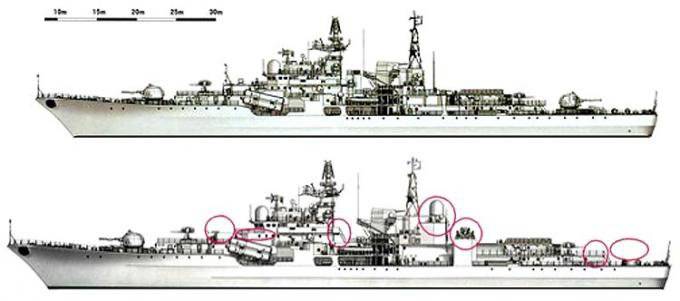
Destroyers pr. 956E (fig. above) and 956EM - general and particular: 1-2x1 130-mm AK-130 guns: 2 - 1x1 - Shtil anti-aircraft missile launcher (24 missiles); 3 - 2x4 anti-ship missiles "3M-80E"; 4 - AP radar "Mineral-E"; 5 - AP radar "Frigate - ME"; 6 - 30-mm gun "AK-630"; 7 - MZRAK "Kashtan"

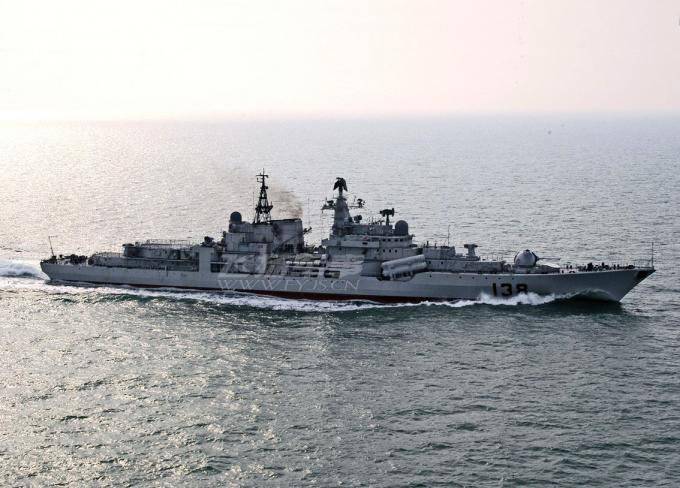
At the moment, the "956s" form a "Russian line" of destroyers of the Chinese fleet, a homogeneous strike formation of which, having powerful strike (32 anti-ship missiles) and anti-aircraft (192 missiles) potentials, is capable of operating in the ocean zone
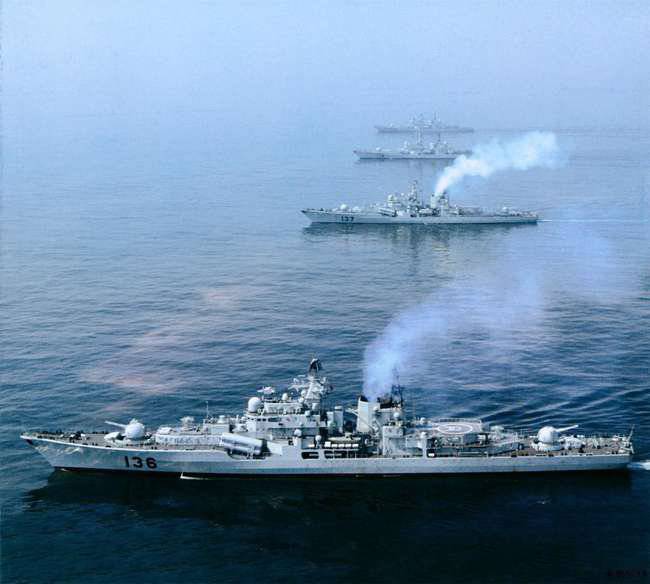
Below is a quote from an article from the Atrina website:
... Project 956-E destroyers built for the PRC at Severnaya Verf have proven themselves well in the Chinese Navy, so the Chinese leadership decided to continue the series. But it was decided to build the next two ships according to the modified project 956-EM, which was developed in the Northern Design Bureau under the leadership of the chief designer V.P. Mishina. Work on project 956-EM (export, modernized) began in 2001. It was immediately assumed that the ship would be significantly different from its predecessors. It was planned to modernize weapons systems, navigation, radar equipment, and control equipment for the main power plant. Work on the project was largely stimulated by the successful implementation of the contract from 1997 for the supply of two project 956-E destroyers to the Chinese Navy.
After negotiations, in early 2002, Rosoboronexport signed a contract with the Ministry of Defense of the People's Republic of China. The total amount of the foreign economic contract was, according to various estimates, from 1 to 1,4 billion dollars. It was expected that the ships would be handed over to the customer in mid-2006.
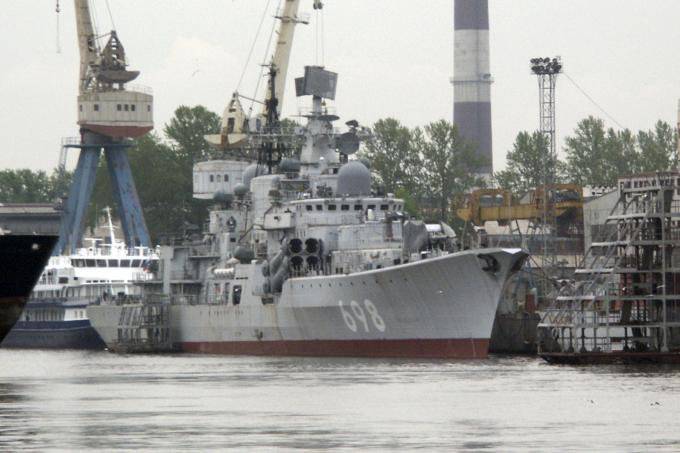
"Eternal" at the outfitting wall of the Northern Shipyard in St. Petersburg May 2006
The then Deputy Prime Minister of the Government of the Russian Federation I.I. Klebanov, immediately after signing the contract, officially announced that the production of the destroyer was a serious matter, and a tender would be announced for it. But, as it turned out, the Shipbuilding Agency is not ready to announce a tender for such a large project. Finally, a competition for placing an order from the PRC was announced, and the projects of the Baltic Shipyard, the Severnaya Verf Shipbuilding Plant and the Yantar Kaliningrad enterprise were presented very quickly. Already on January 19, 2002, at a meeting, the government commission made a choice in favor of the Baltic Shipyard. This was due to the fact that the plant offered the most favorable conditions. The cost of building destroyers was lower than that of other bidders. But it didn't end there. In March, the results of the tender were revised, and by decision of the government, the order for the construction of ships pr.956-EM was transferred to Severnaya Verf, and only the supply of elements and assemblies was assigned to the Baltic Shipyard. The Baltic Shipyard is indeed a manufacturer of pipelines, propeller shafts and propellers for destroyers pr.956-EM and supplied these units for the previous Chinese contract (pr.956-E), which was executed by Severnaya Verf. Under the Chinese contract, the Baltic Shipyard manufactured almost the entire power system for these ships, including auxiliary installations, as well as outboard fittings. In August 2003, the Baltiysky Zavod shipbuilding company supplied Severnaya Verf with boilers for two new destroyers pr.956-EM.
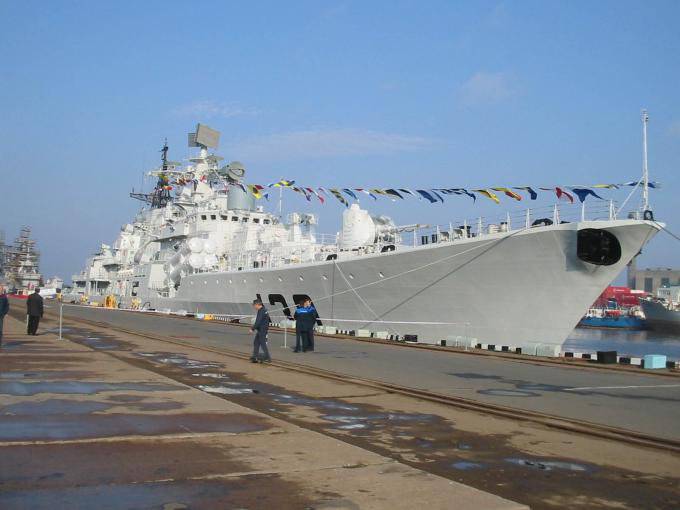
Before handover to China on September 28, 2006
Reportedly, Project 956-EM destroyers differ from the ships of the first delivery in terms of range of strike missile weapons and more advanced air defense. The new modernized Moskit-ME SCRC installed on ships has a firing range of up to 200 km (the basic modification had a range of 120 km). Air defense was strengthened by installing two combat modules of the Kashtan anti-aircraft missile and artillery system (export version of the Kortik air defense system) instead of four AK-30M 630-mm gun mounts. Each of the combat modules has two six-barreled 30-mm machine guns, two launchers with four missiles each, and guidance and control stations. To detect air targets and target designation ZRAK on the roof of the aft superstructure there is a 3R86E1 radar (export version of the Pozitiv station) in a radio-transparent radome.
As you know, the big drawback of the ships pr.956 and pr.956-E was the lack of a permanently based helicopter - there was only a telescopic sliding hangar. On the new ships, this drawback was eliminated by abandoning the aft 130-mm gun mount AK-130 (only one remained - on the bow), in place of which the Shtil air defense system was "shifted", and in the aft superstructure under the main mast was a full-fledged helicopter hangar has been placed for the permanent deployment of the helicopter and the placement of its ammunition. The overall length of the ship and the displacement increased slightly. At the same time, the anti-submarine armament of the EM has not changed.
Destroyers pr.956-EM were laid down in June and November 2002 at the Severnaya Verf Shipbuilding Plant in St. Petersburg. In December 2005, the lead destroyer with tail number 693 was accepted by the commission and transferred to the Chinese Navy, where it was named Taizhou (number 138). The second ship was solemnly launched on July 23, 2004 and towed to the outfitting embankment, where its completion afloat began almost immediately.
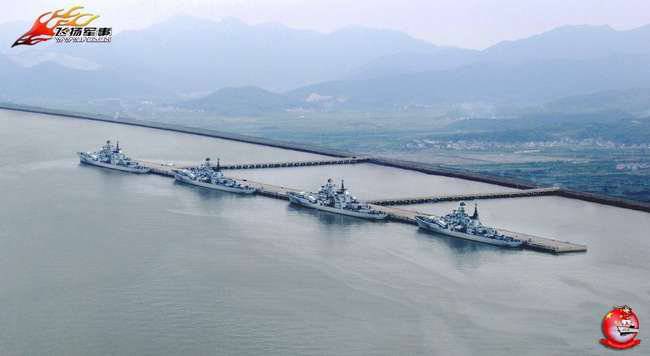
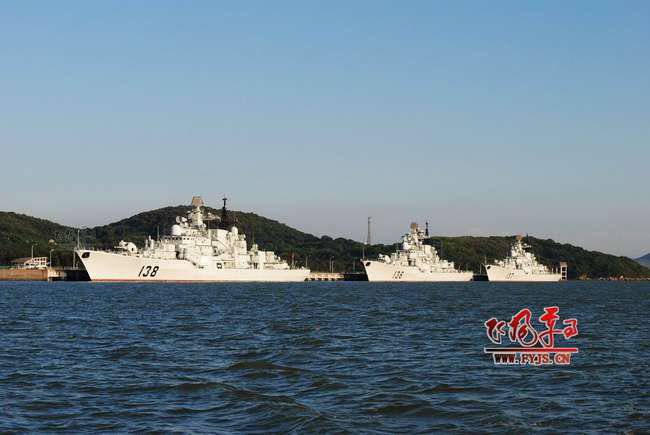
Some nuances of Chinese EM weapons
The strike capabilities of Chinese ships are quite good: supersonic missiles "Moskit" with a flight speed of approx. 3 M and the ability to maneuver with overloads of more than 10 g are a very difficult goal even for ships equipped with the Aegis system with SM-3 missiles (after all, this complex is sharpened to a greater extent to intercept BR); the possibility of interception using the Sea Sparrow complex is very, very doubtful. In addition, there is an advanced version of the YJ-82 (C-802) RCC - YJ-83, which has a supersonic stage (speed 1,5 M at the final stage).
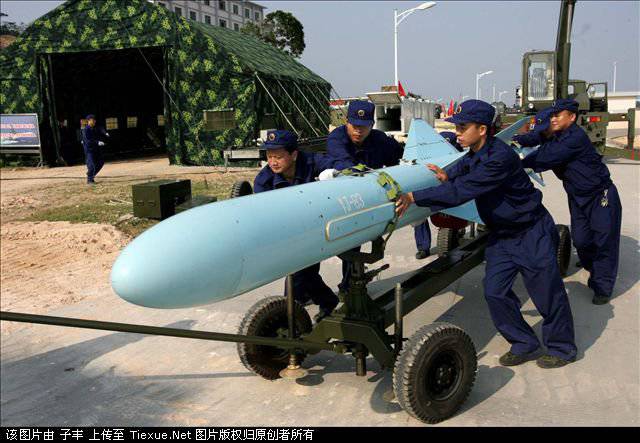 [/ Img]
[/ Img]In addition, there are anti-ship missiles YJ-62. The rocket was developed by China Aerospace Science and Industry Corporation (Third Aerospace Academy). Entered service with the Chinese Navy in 2004. According to experts, in the development of the YJ-62, technologies and components of the Tomahawk missile obtained from Afghanistan and Iraq, as well as Soviet Kh-55 missiles acquired through Ukraine, were used.
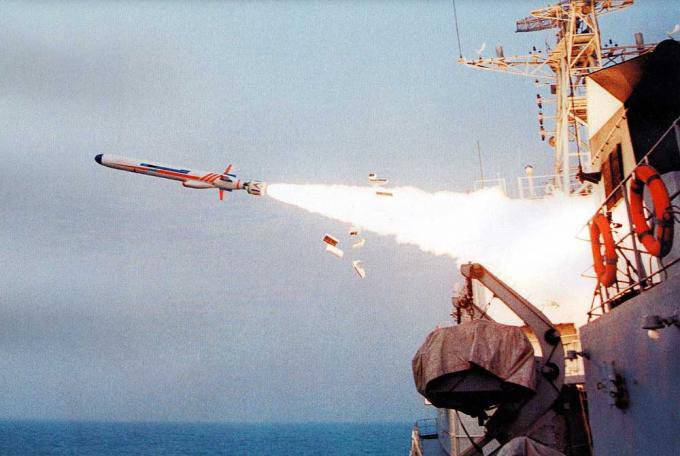
TTH:
Firing range: 40-400 km (280 - for C-602, export version).
Flight speed: 0,6-0,9 M.
Flight altitude above the sea: 7-10 m.
Flight altitude above ground: 30 m.
Dimensions, m:
- length (without starting accelerator) 6,1;
- length (with accelerator) 7,0;
- diameter 0,54;
- wingspan 2,9.
Starting weight: 1350 kg.
Launch booster weight: 210 kg.
Warhead weight: 300 kg.
Air defense is represented by long-range air defense systems (RIF-M; HQ-9), medium-range Shtil-1 complexes and Chinese analogues of short-range Naval Krotal air defense systems HQ-7. The most modern self-defense air defense systems are the Kashtan ZRAK and ZAK AK-630 and type 730 (information about it was in the post about Chinese AB).
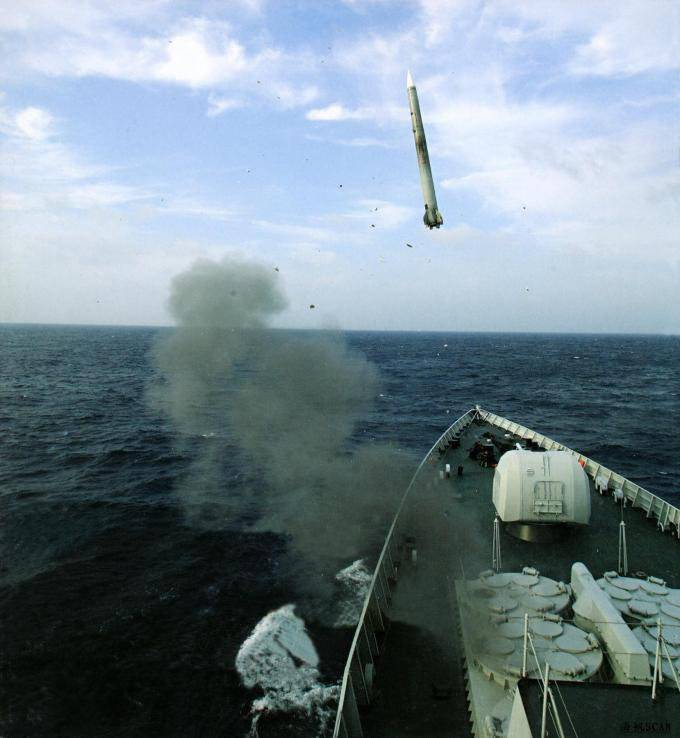
True, there is the following question: why should the Chinese, who put into operation the ships of Project 52 C with long-range air defense systems and radars with PAR (and, probably, with the corresponding ASBU), adopt ships equipped with the RIF-M complex imported from Russia ?

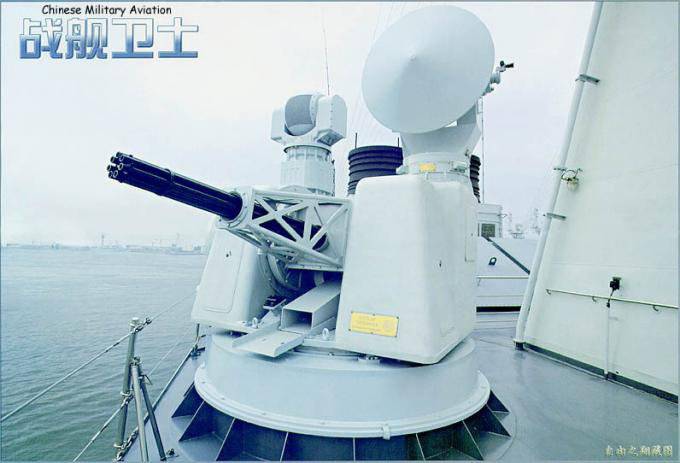
Summarizing, we can say that Chinese destroyers are currently small-scale ships that are models for testing technical solutions and tactics for future use when creating a "large fleet" (so to speak, "sample fleet"). Nevertheless, even now, if Chinese aircraft carriers are put into operation, they are quite capable of providing the AUG in terms of strike capabilities, as well as air defense and anti-aircraft defense.
Possible directions for the development of this class of ships in China can currently be aimed at modernizing the old EM pr. 052 (according to NATO classification - Luhu-class) in the fleet.
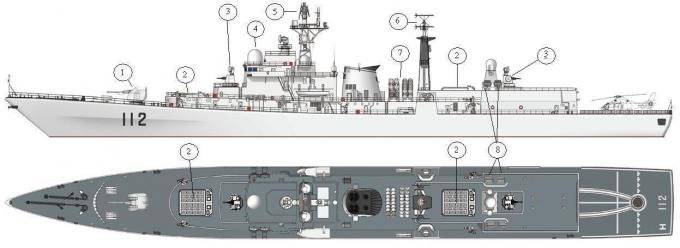
1 - 1x1 100-mm AU "Creusot-Loire T100C" (or its Chinese "analogue"); 2 - 2x16 VPU air defense systems (it is possible to use the air defense system HQ-16); 3 - MZAK "type 730"; 4 - AP radar "Mineral - E"; 5 - AP radar "Fregat-ME"; 6 - early warning radar "type 517"; 7 - 2x4 launchers anti-ship missiles "YJ-62" (you can also use anti-ship missiles JY-83, 2 or 4x4 launchers), 8 - 2x18 launchers LC. (this modernization is speculatively considered in the book by Yu.V. Vedernikov "Modern destroyers of the Chinese fleet: evolution and combat potential").
The option is quite good, especially since the strike potential of these EMs does not correspond to most ships of the same class in regional fleets (Japanese or South Korean navies), and the air defense capabilities are very, very modest. And this despite the fact that the ships are not yet old (commissioned in the mid-90s).
A more realistic option seems to be the construction of an improved version of the EM pr. 052V with the replacement of the Shtil-1 air defense system with beam launchers for the HQ-16 air defense system with a TLU. This air defense system is routinely installed on Chinese frigates URO pr. 054A, so the construction of such ships is quite realistic (this version of the EM is also speculatively considered in Vedernikov's book).
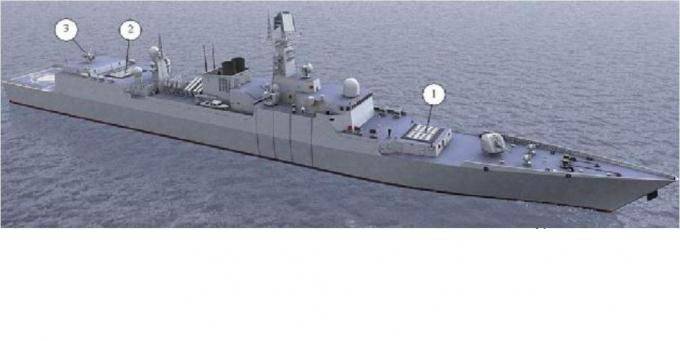
And, finally, the pinnacle of Chinese shipbuilding, the latest Chinese "Aegis" - EM URO type 052D.
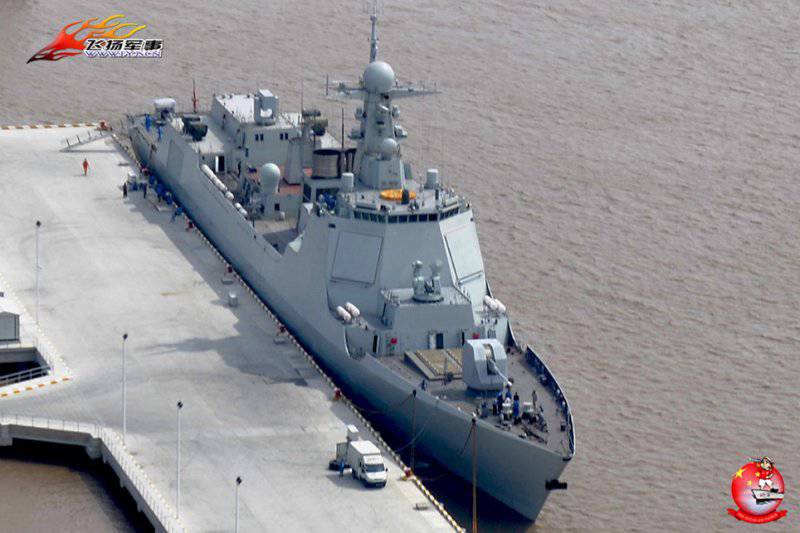
This ship deserves more detailed and detailed attention.
Everything that is known about him, and so far little is known, can be read HERE .
And in conclusion - a comparative image of the evolution of Chinese destroyers from "a" to "z":
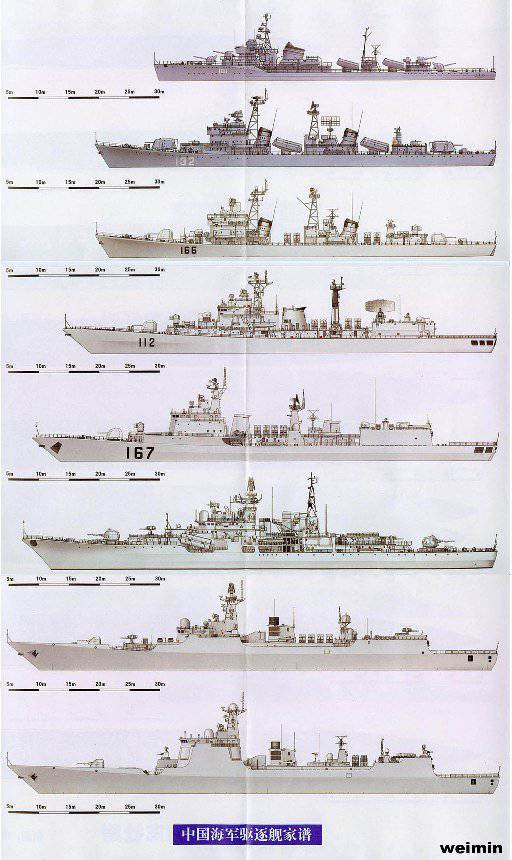
On the materials of the sites:
http://alternathistory.org.ua/pogovorim-o-kitaiskikh-esmintsakh
http://gruzdov.livejournal.com/62193.html
http://doktorkurgan.livejournal.com/12604.html
http://www.navy.ru/publications/books/shelf/vedernikov/chinadestroyers/1.htm
http://flot.com/publications/books/shelf/vedernikov/chinadestroyers/1.htm
http://www.militaryparitet.com/nomen/china/navy/data/ic_nomenchinanavy/23/
http://www.sinodefenceforum.com/navy/ddg-052c-thread-2358.html
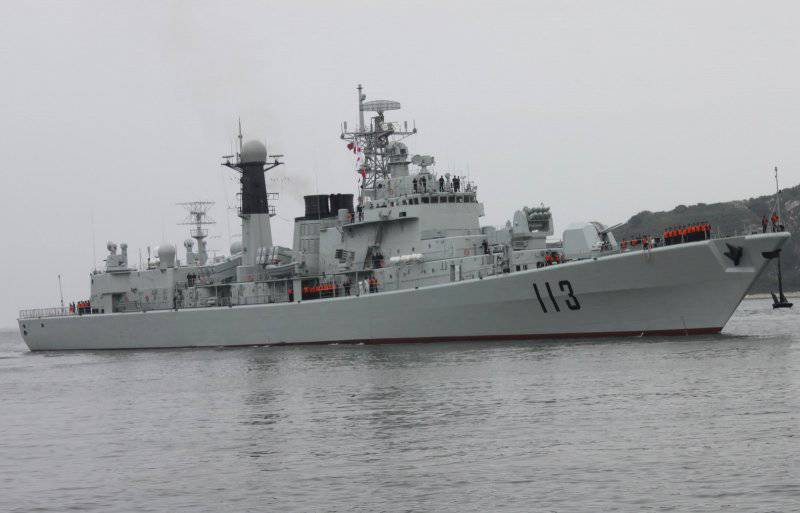

Information